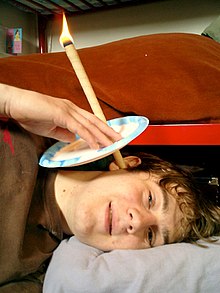Ear candle
As ear candles (or also ear candles ) are hollow candles which, according to the manufacturer , can be used for ear cleaning. They have been offered in Germany since around 1990.
Ear candles are hollow and 20 to 30 cm long, sometimes funnel-shaped, and are made of beeswax , essential oils , gauze and powdered parts of plants, including cotton . The lower end is sometimes wrapped in a thin aluminum foil. Some manufacturers process a filter in the lower part of the ear candle. When using it, the person lies on their side. The ear candle should be inserted vertically into one ear with a rotating movement without pressure so that the ear canal is hermetically sealed. Then the candle is lit. This form of application is intended to produce a cleaning effect by introducing heat into the ear canal, which should make the wax a little softer.
Melted wax drops can cause burns in the ear canal. The fact that the candles have a cleaning effect cannot be justified either physically or chemically. The fact that the candles have a therapeutic effect is considered " implausible and demonstrably wrong". Burns and eardrum injuries have been reported. The US health authorities , among others, advise against its use and in 2013 issued an import ban because it is a medical product that is dangerous and has no proven effect.
In connection with a lawsuit for unfair competition, the Frankfurt am Main regional court ruled on February 7, 2007 (file number 2-06 O 218/06): “The application of Hopi candles [...] as a therapeutic agent [...] is suitable for misleading, as claims of this kind cannot be based on adequate scientific evidence. "
If the wax glands form an excessive amount of ear wax, ENT doctors recommend having this professionally removed by a doctor every three months.
Although such candles are also marketed under the name "Hopi" candles, they do not come from the Hopi tribe and are not associated with any other Indian tribe.
literature
- Daniel R. Seely et al .: Ear Candles-Efficacy and Safety. In: The Laryngoscope. Volume 106, No. 10, 1996, pp. 1226-1229. doi: 10.1097 / 00005537-199610000-00010
- E. Ernst: Ear candles: a triumph of ignorance over science. In: The Journal of Laryngology & Otology. Volume 118, No. 1, 2004, pp. 1-2. doi: 10.1258 / 002221504322731529
Web links
- Hopi ear candles - dangerous bullshit. On: Spektrum.de , January 1, 2011.
- Health risks from ear candles. On: aerzteblatt.de , February 22, 2010.
- Lisa Roazen: Why Ear Candling Is Not a Good Idea. On: quackwatch.org , May 12, 2010.
Individual evidence
- ↑ E. Ernst: Ear candles: a triumph of ignorance over science . In: The Journal of Laryngology & Otology . tape 118 , no. 1 . Cambridge University Press, 2004, doi : 10.1258 / 002221504322731529 .
- ↑ Ear Candling: A Fool Proof Method, or proof of Foolish Methods? On: audiologyonline.com , December 12, 2005.
- ^ Listen up: Beware of the "ear candle" . On: CBC / Radio-Canada . February 22, 2000.
- ↑ J. Rafferty, A. Tsikoudas, BC Davis: Ear candling - Should general practitioners recommend it? In: Can Fam Physician . tape 53 , no. December 12 , 2007, pp. 2121-2122 , PMID 18077749 .
- ^ Ear Candles: Risk of Serious Injuries. On: fda.gov , May 9, 2013.
- ↑ Import Alert 77-01: Detention Without Physical Examination Of Ear Candle. On: fda.gov , June 20, 2013.
- ^ Promotion of Hopi candles. Judgment of the Frankfurt am Main regional court in connection with violations of the law against unfair competition. In: Medicine Products Law (MPR). No. 1, 2008, pp. 19-22. Full text (PDF)
- ↑ Tips for proper ear care. On: hno-aerzte-im-netz.de , accessed on May 5, 2019.
- Jump up ↑ Hopi ear candles - dangerous bullshit. On: Spektrum.de from January 1, 2011.
-
↑ Leigh J. Kuwanwisiwma: The Authenticity of the Hopi Candle. Accessed May 5, 2019 .
“The Hopi Cultural Preservation Office is not aware of Hopi people ever practicing 'Ear Candeling.' [...] This therapy should not be called 'Hopi Ear Candeling.' The history of Ear Candeling should not refer to being used by the Hopi Tribe. Use of this false information with reference to Hopi should be stopped. "
“The Hopi Culture Preservation Bureau has no knowledge of the Hopi people ever using 'ear candles'. […] This therapy should not be called 'Hopi Candle Treatment'. The history of the ear candles should not imply that they were ever used by the Hopi tribe. The misinformation regarding the Hopi should be stopped. "
- Leigh J. Kuwanwisiwma
